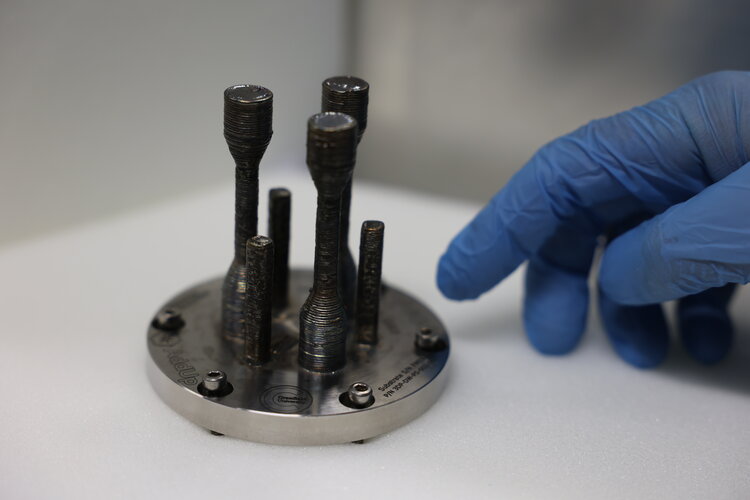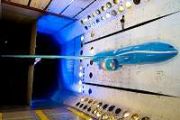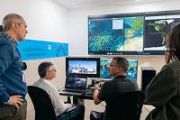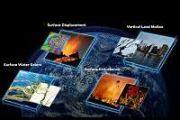
Copernical Team
Metal made in space lands on Earth
 Image:
Image:
The first metal 3D part ever created on orbit has landed on Earth.
The sample was produced in ESA’s Metal 3D Printer on the International Space Station. Now, it’s on Earth for the first time, at ESA’s technical heart in the Netherlands (ESTEC).
The printer, developed by Airbus and its partners, was installed in the Columbus module by ESA astronaut Andreas Mogensen during his Huginn mission in January 2024. In June, the facility succeeding in making its first print, a curvy line in the shape of an 'S’. In summer, the printer produced its first full sample, and then a
Call for information on low Earth orbit navigation

The European Space Agency (ESA) is issuing a Request for Information (RFI) via OSIP for European industry to show interest and provide information on satellite technology that could enable the proposed next phase of ESA's LEO-PNT (Low Earth Orbit Positioning Navigation and Timing) programme, focused on industrialisation and in-orbit validation. ESA is looking to learn about production capability of payload building blocks and suitable off-the-shelf satellite platforms to accommodate them.
ESA seeks companies to commercialise inventions

Year after year, ESA creates new technologies and applications, typically filing 10 new patent applications per year. As a result, ESA has built a portfolio of around 550 patents and patent applications to date. Now, through a permanent open call, companies and startups from around the world can submit their ideas on how they would mature these patents, paving the way for improved commercialisation of ESA's innovations.
Today's forecast Partially cloudy skies on an ultra-hot Neptune
 New insights into the extreme atmosphere of LTT 9779 b, a rare ultra-hot Neptune, have emerged from observations conducted using the James Webb Space Telescope (JWST). Led by Louis-Philippe Coulombe, a graduate researcher at Universite de Montreal's Trottier Institute for Research on Exoplanets (IREx), the study sheds light on the planet's unique weather patterns and atmospheric composition.
New insights into the extreme atmosphere of LTT 9779 b, a rare ultra-hot Neptune, have emerged from observations conducted using the James Webb Space Telescope (JWST). Led by Louis-Philippe Coulombe, a graduate researcher at Universite de Montreal's Trottier Institute for Research on Exoplanets (IREx), the study sheds light on the planet's unique weather patterns and atmospheric composition. NASA's Europa Clipper Leverages Mars for Critical Gravity Assist
 On March 1, NASA's Europa Clipper will execute a close flyby of Mars, passing just 550 miles (884 kilometers) above the planet's surface. This maneuver, known as a gravity assist, will adjust the spacecraft's trajectory and prepare it for a crucial stage in its journey toward Jupiter's icy moon, Europa. In addition to refining its path, the flyby presents an opportunity for mission scientists to
On March 1, NASA's Europa Clipper will execute a close flyby of Mars, passing just 550 miles (884 kilometers) above the planet's surface. This maneuver, known as a gravity assist, will adjust the spacecraft's trajectory and prepare it for a crucial stage in its journey toward Jupiter's icy moon, Europa. In addition to refining its path, the flyby presents an opportunity for mission scientists to Asteroid 2024 YR4 No Longer a Significant Impact Threat
 The European Space Agency's (ESA) Planetary Defence Office has significantly downgraded the risk posed by asteroid 2024 YR4, reducing its probability of impacting Earth in 2032 to a negligible 0.001%.
Initially detected on December 27, 2024, by the ATLAS telescope in Rio Hurtado, Chile, the near-Earth asteroid was quickly flagged by ESA's automated warning system, Aegis, as having a small
The European Space Agency's (ESA) Planetary Defence Office has significantly downgraded the risk posed by asteroid 2024 YR4, reducing its probability of impacting Earth in 2032 to a negligible 0.001%.
Initially detected on December 27, 2024, by the ATLAS telescope in Rio Hurtado, Chile, the near-Earth asteroid was quickly flagged by ESA's automated warning system, Aegis, as having a small Chance huge asteroid will hit Earth down to 0.001 percent
 The chance that a football field-sized asteroid capable of destroying a city will strike Earth in 2032 has fallen to 0.001 percent, the European Space Agency said on Tuesday.
A week ago, the asteroid set a new record for having the highest probability of hitting Earth - 3.1 percent according to NASA and 2.8 percent according to the ESA. The planetary defence community has been scanning the
The chance that a football field-sized asteroid capable of destroying a city will strike Earth in 2032 has fallen to 0.001 percent, the European Space Agency said on Tuesday.
A week ago, the asteroid set a new record for having the highest probability of hitting Earth - 3.1 percent according to NASA and 2.8 percent according to the ESA. The planetary defence community has been scanning the Laser-powered spectrometer tested on Earth may uncover microbial fossils on Mars
 The possibility that microbial life once thrived in ancient Martian waters has intrigued scientists for years. Now, researchers have demonstrated a method to detect fossilized microbes in gypsum deposits, offering a promising approach for future Mars missions to confirm past life on the Red Planet.
"Our findings provide a methodological framework for detecting biosignatures in Martian sulf
The possibility that microbial life once thrived in ancient Martian waters has intrigued scientists for years. Now, researchers have demonstrated a method to detect fossilized microbes in gypsum deposits, offering a promising approach for future Mars missions to confirm past life on the Red Planet.
"Our findings provide a methodological framework for detecting biosignatures in Martian sulf Private US company set for second Moon landing attempt
 Intuitive Machines made history last year as the first private company to put a robot on the Moon, although the triumph was marred by the lander tipping onto its side.
Now, the Houston-based firm is gearing up for a second attempt, determined to achieve a perfect touchdown.
Intuitive Machines' hexagonal-shaped lander, Athena, is set to launch aboard a SpaceX Falcon 9 rocket during a wind
Intuitive Machines made history last year as the first private company to put a robot on the Moon, although the triumph was marred by the lander tipping onto its side.
Now, the Houston-based firm is gearing up for a second attempt, determined to achieve a perfect touchdown.
Intuitive Machines' hexagonal-shaped lander, Athena, is set to launch aboard a SpaceX Falcon 9 rocket during a wind NASA's Lucy Spacecraft Takes Its 1st Images of Asteroid Donaldjohanson
 NASA's Lucy spacecraft has its next flyby target, the small main belt asteroid Donaldjohanson, in its sights. By blinking between images captured by Lucy on Feb. 20 and 22, this animation shows the perceived motion of Donaldjohanson relative to the background stars as the spacecraft rapidly approaches the asteroid.
Lucy will pass within 596 miles (960 km) of the 2-mile-wide asteroid on Apr
NASA's Lucy spacecraft has its next flyby target, the small main belt asteroid Donaldjohanson, in its sights. By blinking between images captured by Lucy on Feb. 20 and 22, this animation shows the perceived motion of Donaldjohanson relative to the background stars as the spacecraft rapidly approaches the asteroid.
Lucy will pass within 596 miles (960 km) of the 2-mile-wide asteroid on Apr 



































